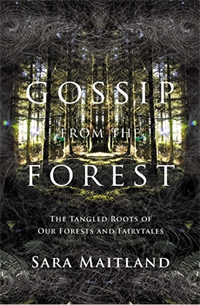 Why do forests capture our imagination? And why are so many fairytales, at least in the Northern European tradition, rooted in forests? Sara Maitland’s Gossip from the Forest is a fascinating and freewheeling exploration of how people shape the natural world, which shapes the tales we tell, which in turn shape us.
Why do forests capture our imagination? And why are so many fairytales, at least in the Northern European tradition, rooted in forests? Sara Maitland’s Gossip from the Forest is a fascinating and freewheeling exploration of how people shape the natural world, which shapes the tales we tell, which in turn shape us.
Maitland opens with the original meaning of the word ‘gossip’ (“one who has contracted a spiritual relationship to another, or a familiar acquaintance or friend”). As a feminist writer, she is reclaiming a term she believes has been trivialized to dismiss the power of women’s communication. (The American edition of the book has truncated the title to From the Forest, which is a shame.)
The chapters run from March through February, and in each Maitland visits a different forest in England or Scotland, and ends with a unique retelling of a familiar fairytale. There is much to ponder and to absorb. The descriptions of coppicing and pollarding were surprising to me, and I had to overcome my reflexive distaste for human interventions in the growth of forest trees. In a deciduous forest setting, these practices can be beneficial not only to humans (who need wood for fuel, building, and other uses) but to the trees as well. She notes that coppicing extends the lifespan of oaks, for example. Pollarding, which is done higher up on the tree, makes the thin branches accessible to humans but not to browsing deer and other mammals.
Another observation that intrigued me was the venerated position beech trees hold in British culture (see Richard Mabey’s book Beechcombings, or the widespread use of beeches in private estates to “posh up the landscape,” to quote the book) compared to the birch, which the author prefers for its aesthetic and useful qualities. Beech is thought of as native, but is widespread across Europe; in Britain it mainly grows in the southern half of the country. She recalls her father’s saying that “tyranny is like a beech tree; it looks very fine but nothing grows under it.”
This is a book with a wide reach. Maitland touches on the history of the powerful and the powerless as evidenced in policies like enclosure (ending public rights and access to land which was once held in common), and on the cultural and psychological underpinnings of tales in which common folk are skilled and wise while kings are fools and landed gentry are consumed by greed. Her walks through the forest evoke the mystery of the natural world and the stories we tell to understand our place in it. Adam Lee, Maitland’s son (who took the photographs which accompany the text), provides a useful image which summarizes the essence of the book: fairytales, forests, and people are interdependent, like mycorrhizae and tree roots.
Reviewed by Rebecca Alexander